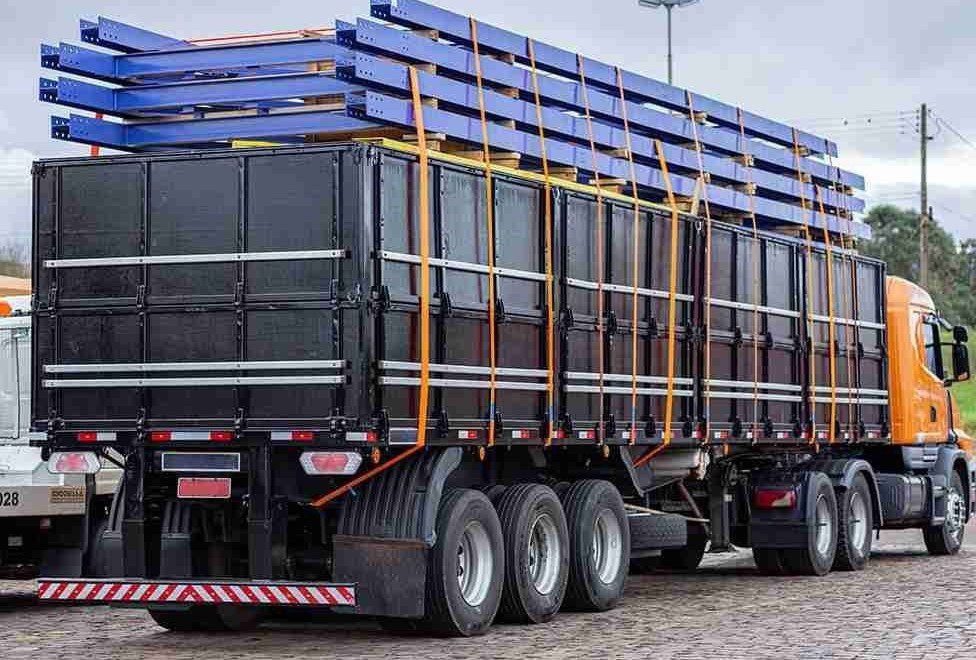No products in the cart.
Straps
Load lashing for transport logistics
Load lashing is a fundamental procedure to reinforce the safety and quality of transportation and optimize logistics.
Drivers and transport companies must have a good understanding of lashings. After all, they are responsible for ensuring the safety and integrity of the load throughout the entire transportation process.
Another important precaution is to have adequate lashing equipment such as polyester straps, hooks, and hand winches. In addition, it is necessary to observe the Contran regulations on correct lashing procedures, which are mandatory throughout the national territory.
In this article, we’ll cover some important precautions when lashing load and provide tips for increasing the safety and efficiency of your transportation logistics.
Know why a good lashing is so important
Load lashing requires a lot of attention and care, since any failure can pose risks to the safety and integrity of the merchandise. When proper care is not taken, the probability that the load moves on the body is greatly increased.
In the case of a sudden brake, the tie-down will serve to guarantee the driver that nothing will fall off the truck. In addition, in a sharp curve, it helps to ensure that the load does not move and change the balance of the truck, a dangerous situation that even involves the risk of overturning.
Lashing failures can cause product damage, overturning., or total detachment of the load. Furthermore, accidents can endanger the lives of both the driver and the people they cross on the road. Therefore, a suitable lashing is important to guarantee the safety of the transported products and the integrity of the people involved in the operations.
Learn about the different lashing types
The first precaution to take to make a good lashing is to know well the different procedures for each type of load. This is a very important precaution, since the same truck can transport goods with different characteristics of weight, size and fragility.
To properly secure the load, it is necessary to consider factors such as the quality and resistance of the equipment used, the vehicle’s anchoring points, the distribution of the load on the bodywork, the forces on the load during the journey, among others. In this way, it is possible to minimize possible dangerous situations that may occur during transportation, such as detachment or displacement of the load.
When loading the vehicle, never put more weight on different areas of the trailer, as this can cause vehicle instability. Excess weight can cause uncontrolled loading, overturning, and even damage to the hydraulic equipment that lifts the trailer.
When transporting liquid cargo, you should pay attention to the level of the tank. If it is not full, the movement of the liquid will greatly affect the stability of the truck, especially when cornering. The same care applies to hanging or live loads.
Observe the Contran rules
The rule that determines how cargo lashing must be done is Resolution 676 of the National Transit Council (Contran). It Updated Resolution 552, which brought major innovations to industry standards. Therefore, knowing and putting these rules into practice is important for safe transportation and also to avoid fines and other penalties.
The new regulation prohibits, for example, the use of ropes in the lashing. This material can only be used to secure the tarp. After all, the ropes have little elasticity and resistance, which could create a high risk of accidents.
According to regulations, textile straps must be used to secure the load. Other materials such as steel cables and chains can also be used.
For good lashing, lashing straps with a total tensile strength of at least twice the weight of the load should be used. Additionally, equipment such as grab bars, screens, rails, and spacers can be used as additional safety devices.
Another Contran measure, resolution 588, prohibits the use of anchor hooks attached directly to the wooden beam of the bodywork. These must be anchored to the chassis and to the metal crossmembers.
Use quality equipment
Equally important is to use appropriate equipment for each type of lashing, such as straps, hooks and hand winches. In addition, it is also important to pay attention to its quality and origin.
A good recommendation is to pay attention to some important information when buying the equipment:
- Manufacturer’s Name;
- Length;
- Maximum load in direct traction;
- Manufacturing date;
- Brazilian standard Number (NBR);
- Traceability code.
Also pay attention to the bodywork model
In addition to the issues already mentioned, it is very important to pay attention to the fact that each type of bodywork will require fixing the load in a different way.
The anchor point is also very important, as there is no use for the truck driver to use a resistant equipment if the anchor point does not support the weight of the load when it is most needed, such as hard braking. Therefore, the anchor points must be in good condition and sized to support the load lashing.
It should be remembered that some bodies do not have side latches for hooks or do not have the necessary rigidity to tie certain loads. In these cases, the fixing can be done directly on the chassis, using the appropriate equipment.
Get to know the Robustec’s lashing equipment line
The Robustec’s lashing straps line has models with hooks in flat, “J”, triangle, “Moto”, claw and swivel formats, available with or without hand winch. These products offer various mounting and capacity options, depending on your application and the needs of each customer.
The straps are 100% polyester and are chemically treated for less water absorption. They also have anti-UV protection, resistant to sunlight and withstand temperatures ranging between -40°C and +100°C.
In the same way, Robustec’s hooks and hand winches are manufactured from welded carbon steel and finished with electrolytic galvanization and/or epoxy powder painting. In addition, they receive heat treatment.
Due to these characteristics, Robustec lashing straps and hand winches offer total resistance and comply with Contran’s 676 and 552 Standards.
Do you want to know more about Robustec’s lashing straps and hand winches? Enter here!



